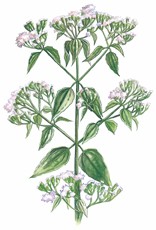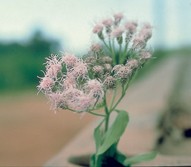Chromolaena odorata

What to look for
A fast-growing shrub or scrambling weed that can grow several metres in height. The plant has branches and leaves in opposite pairs and produces bunches of fluffy white to pink flowers during June to September.
What you can do
- Do not move plants, plant material or soil out of the Torres Strait Protected Zone to the Torres Strait Permanent Biosecurity Monitoring Zone, or from either zone to mainland Australia without a permit and an inspection by a departmental biosecurity officer.
- Report any signs of suspect exotic weeds to the department by phone on +61 7 4241 7800 or email NAQS.

Profile
Siam weed is one of the world’s worst weeds, with a phenomenal growth rate and massive seed production. Plants can reach 10 metres by scrambling through adjacent vegetation. It forms impenetrable thickets to three metres tall in open sites, such as river banks and pastures. It can smother tropical fruit crops, young forestry plantations and pastures. It is also a serious environmental weed, invading native woodlands and posing a major fire hazard in the dry season.
Identification
Branches and leaves grow in opposite pairs. Leaves are triangular with three prominent veins and toothed margins. Crushed leaves are mildly aromatic. From June to September it produces masses of fluffy white to pale pink flowers. The seeds are 4–5 mm long with a parachute of pale bristles that helps them travel in the wind and adhere to clothing. The seeds are notorious for spreading via vehicles, earthmoving and construction equipment.

Siam weed flowers
Distribution
Siam weed comes from tropical America but has become a serious weed in Africa, South East Asia and Papua New Guinea. There have been a number of detections of this weed in Queensland and the Cocos Islands. From 2013 the Siam weed eradication program was replaced with a National Management Strategy that stresses the importance of early detection and eradication if found anywhere outside the containment zone in north Queensland.
Threat
If Siam weed established widely in Australia, control would cost millions of dollars a year. Tropical crops, grazing land and natural ecosystems would be threatened.

Siam weed forms dense infestations
Keep a Top Watch!
Be vigilant for any new and unfamiliar plants in your region. Siam weed could potentially invade much of Australia’s tropical and subtropical coastal fringe from the Kimberley region to northern NSW. Learn what it looks like and contact the department if you think you’ve seen Siam weed plants in your region.
Report any unusual shrubs that you don’t recognise
